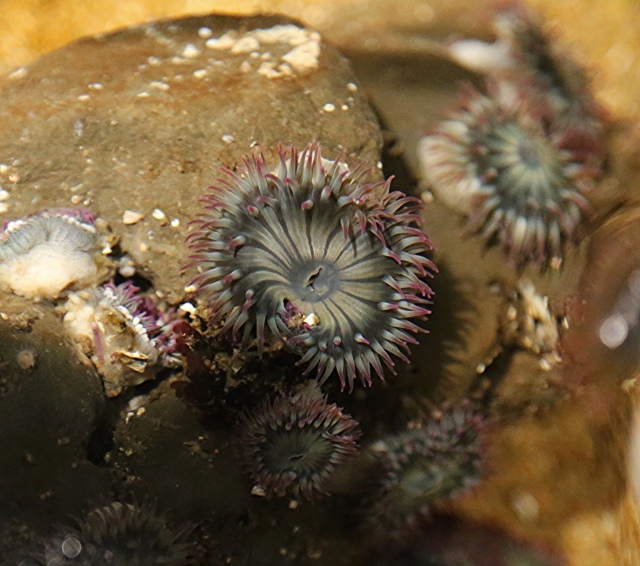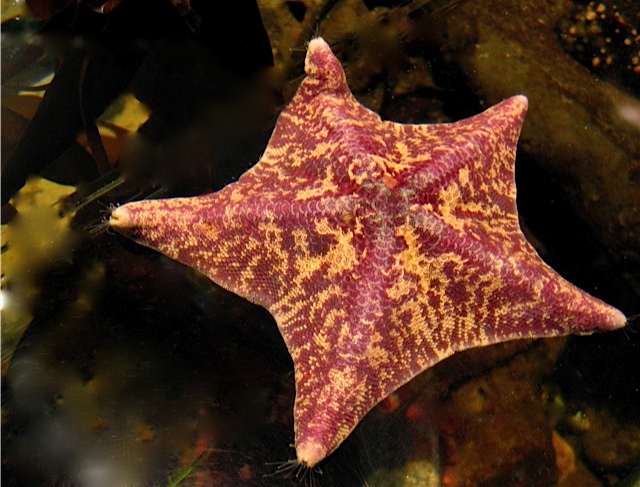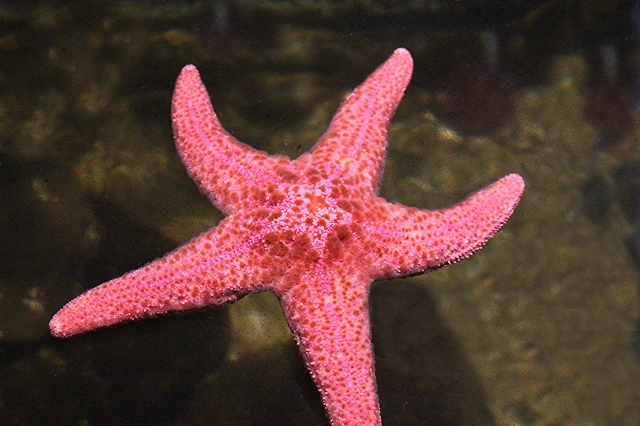TAXONOMY
Kingdom: Animalia
Phylum: Echinodermata
Class: Asteroidea
Order: Forcipulatida
Family: Asteriidae
Genus/species: Pisaster ochraceus
GENERAL CHARACTERISTICS: Color varies from orange, violet, dark brown or mottled, but very rarely ochre. One study showed that less than two percent of the individuals in three local Northern California populations were “ochre” in color. When dead and dry they become ochre in color.

The aboral surface contains many small spines (ossicles) that are arranged in a netlike or pentagonal pattern. Papulae or coelomic pouches give the seastar’s surface a soft, fuzzy appearance. They are used for respiration and waste excretion. P. ochraceus may have an arm radius of up to 28 cm (11 in), but the more common radius is half that figure. They typically have five arms or rays, but the number can range from four to seven. Like all sea stars, an adult P. ochraceus has tube feet which they use for locomotion and for handling prey.
DISTRIBUTION/HABITAT: Ochre stars range from Alaska to Santa Barbara County, California. They prefer the low-to-mid intertidal zones on rocky shores, especially on mussel beds, and are also found in the subtidal zone to a depth of 88 m (288 ft). Juveniles are found in crevices and under rocks.

DIET IN THE WILD: California mussels are the favored and locally abundant prey. They also consume acorn barnacles, emarginated dogwinkles, gooseneck barnacles, owl limpets, etc. They can insert their stomach into slits as narrow as 0.1 mm between the valves of bivalves and begin digestion.
ACADEMY DIET: Manila clams, chopped fish, large krill, chopped squid; it also eats other exhibit inhabitants.

REPRODUCTION: They are mainly dioecious (separate sexes). Male gametes are produced, but at a later date only females gametes are produced. During a transitional period, both eggs and sperm are produced. The gonopores of the individual gonads open at the bases of the arms. Fertilization is external. Larvae are free-swimming and plankton-feeding.
LIFESPAN: Up to 20 years


PREDATORS: Adults are eaten by sea otters and seagulls. According to Dr. Thomas Niesen, the sea otter can crunch them up but is also known to bite off the tips of the arms and suck out the gonads.
REMARKS: One study showed that less than 2% of the individuals in three local Northern California populations were “ochre” in color. When dead and dry they become ochre in color.
P. ochraceus tolerate strong surges, large temperature changes, dilution by rainfall. It is resistant to desiccation and it can tolerate a loss of thirty-percent of its body weight in body fluids.
Sea stars can regenerate lost arms with a portion of the central disc intact and in some species from a single arm.
NOTE: SEA STAR WASTING SYNDROME has become a major issue in both the Pacific and Atlantic Oceans since 2013. For an excellent summary check this link to the University of Santa Cruz 9-9-14. http://www.eeb.ucsc.edu/pacificrockyintertidal/data-products/sea-star-wasting/updates.htm
Fitzgerald Marine Reserve. www.fitzgeraldreserve.org/newffmrsite/wp-content/uploads/...
11-17-14 Recent research identifies a virus (Parvoviridae) to be responsible for the wasting disease. Introduced virus was able to infect healthy sea stars with the virus, which then leads to the wasting symptoms. Published in the Proceedings of the National Academy of Science. http://theconversation.com/mystery-virus-that-turned-millions-of-starfish-into-goo-is-finally-identified-34336
Additional References
California Academy of Sciences Docent Tidepool Guide 2015
Woods Hole www.whoi.edu/science/B/people/kamaral/SeaStar.html
Bishop Museum hbs.bishopmuseum.org/pubs-online/pdf/op11-8.pdf
Encyclopedia of Life eol.org/pages/598469/details
Animal Diversity Web, U of Michigan animaldiversity.ummz.umich.edu/accounts/Pisaster_ochraceus/
Ron’s WordPress Shortlink http://wp.me/p1DZ4b-sC
Ron’s flickr https://www.flickr.com/photos/cas_docents/3407968572/in/set-72157608501343477/



























